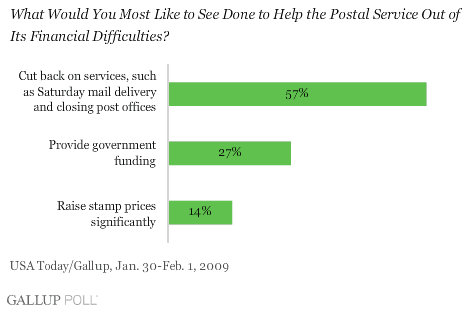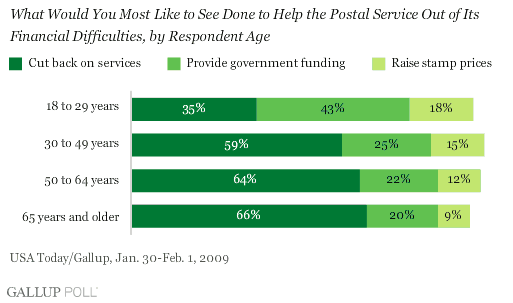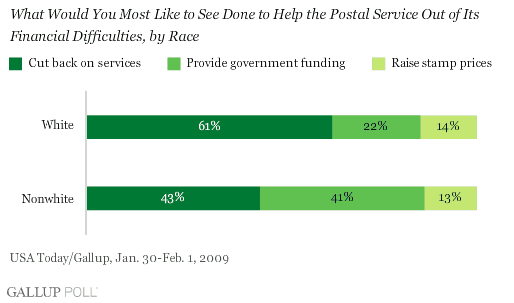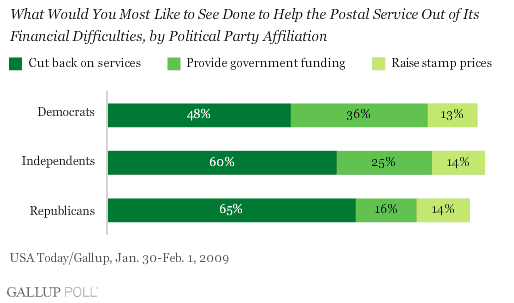PRINCETON, NJ -- When given a choice of three options for helping the U.S. Postal Service out of its financial difficulties, a majority of Americans prefer cutbacks in services -- such as ending Saturday mail delivery and closing post office branches -- to either government assistance or higher stamp prices.

The Postal Service has lost nearly $8 billion over the last two years, and, with sharp declines in the amount of mail being sent, it is facing similar or larger losses in the future. It has asked Congress for permission to cut back to five-day-a-week delivery, and recently received permission to raise postage prices; this will take effect in May.
With only 27% preferring government assistance -- something the post office has not received since 1982 -- and 14% preferring significantly higher stamp prices, Americans appear more than willing to give up some of the conveniences the Postal Service has long offered, including six-day-a-week delivery and thousands of local post office branches.
It is possible the limited support for government funding of the Postal Service may reflect concern over the vast amounts of money Washington is spending in an attempt to revive the economy and help out struggling industries. The poll provides some support for this idea, as those who said they were "very closely" following news about the economic stimulus plan Congress was debating favored cuts in postal services over government funding by a 43-point margin (64% to 21%). That compares to a smaller 25-point margin (54% to 29%) among those who were less attentive to the stimulus debate.
Nearly every key demographic subgroup is willing to accept reduced postal services rather than higher prices or government assistance. The notable exception is young adults -- among those aged 18 to 29, just 35% favor cuts in services, while 43% would like to see the government provide funds to keep the Postal Service running as now.

Also, nonwhites (41%) are nearly twice as likely as whites (22%) to favor government assistance, and significantly less likely than whites to advocate cuts in services.

There are modest political party differences. While the greatest number of Republicans, independents, and Democrats all favor cuts in services, Republicans (65%) are more likely than Democrats (48%) to do so. In turn, Democrats (36%) are more likely than Republicans (16%) to favor government assistance.

Implications
Americans seem willing to forgo some of the Postal Service conveniences they have become accustomed to, as opposed to paying to keep those services directly (through higher stamp prices) or indirectly (through taxpayer funds). This is an attitude shared widely by Americans of nearly every demographic or attitudinal characteristic.
Survey Methods
Results are based on telephone interviews with 1,027 national adults, aged 18 and older, conducted Jan. 30-Feb. 1, 2009. For results based on the total sample of national adults, one can say with 95% confidence that the maximum margin of sampling error is ±3 percentage points.
Interviews are conducted with respondents on land-line telephones (for respondents with a land-line telephone) and cellular phones (for respondents who are cell-phone only).
In addition to sampling error, question wording and practical difficulties in conducting surveys can introduce error or bias into the findings of public opinion polls.
